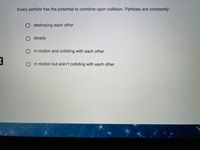
Chemistry
10th Edition
ISBN: 9781305957404
Author: Steven S. Zumdahl, Susan A. Zumdahl, Donald J. DeCoste
Publisher: Cengage Learning
expand_more
expand_more
format_list_bulleted
Question

Transcribed Image Text:Every particle has the potential to combine upon collision. Particles are constantly:
O destroying each other
O steady
O in motion and colliding with each other
in motion but aren't colliding with each other
Expert Solution
This question has been solved!
Explore an expertly crafted, step-by-step solution for a thorough understanding of key concepts.
This is a popular solution
Trending nowThis is a popular solution!
Step by stepSolved in 2 steps

Knowledge Booster
Learn more about
Need a deep-dive on the concept behind this application? Look no further. Learn more about this topic, chemistry and related others by exploring similar questions and additional content below.Similar questions
- Use your data to calculate the number of Calories in a 3.4 g sugar cube. (Molecular mass of sugar = 342.2965 g/mol; ΔHcomb sugar = 5639 kJ/mol; 1 Calorie = 1 Kcal)arrow_forwardInitially 10.0 mol of ammonia gas is injected into a 4.0 L container. At equilibrium 1.2 mol of nitrogen gas is found in the container. The number of moles of ammonia gas at equilibrium would be? 2NH3(g) + 94 kJ <=====> N2(g) + 3H2(g)arrow_forward1. For the reaction: 2NH3(g) + CO2(g) (NH2)2CO(s) + H2O(g) AH = - 330 kJ Predict how each of the following changes would impact a reaction that is currently at equilibrium. That is, which way would the reaction progress in order to respond to the change in the system to regain equilibrium (use arrows to show the direction of change that would occur to return back to equilibrium). Explain your reasoning for each part.arrow_forward
- Use arrows (up / down) to indicate the affect of each of these disturbances (stresses) on the concentration of the reactants and products in this equilibrium: 9 KJ + 2 S02 9) + 02 (9) = 2 S03 (9A disturbance affect on affect on affect on ISO2] [02] ISO3] decrease [SO2] increase [02] increase [SO3] increase pressure decrease temp Period 4 CHEarrow_forwardVolume of HCI (mL) Volume of NaOH (mL) Temperature of HCI (°C) Temperature of mixture after reaction (°C) Temperature difference (°C) Number of joules evolved (J) (enter a positive value) Moles of H* that were neutralized (mol) Joules evolved per mole of H* (J/mol) Trial 1 50.0 50.0 27.4 31.8 4.4 X Ⓒ x Trial 2 50.0 50.0 27.4 31.8 4.4arrow_forwardQuestion 11 of 13 Submit What is the missing value in the table below? Reaction AH (kJ/mol) A - B -10 В — С A → C kJ/mol 1 2 3 4 6. C 7 8 +/- x 10 0 Tap here or pull up for additional resources LOarrow_forward
- Please answer ALL parts of the question and show your work. Consider this reaction: 2H2S(g) + 3O2(g) <-----> 2H2O(g) + 2SO2(g) H= -1036 kJ Predict whether the forward or reverse reaction will reestablish equilibrium is disturbed by (a) expanding the container (b) removing SO2 (c) rasing the temperature (d) water vapor is addedarrow_forwardFor the exothermic reaction 4 NH3(g) +7 02(g)- => 4 NO2(g) + 6 H20(g) which change will increase the quantity of NO2 in the mixture? O A. increasing temperature OB. decreasing container volume OC. adding Ne(g) O D. adding H20(g) O E. adding a catalystarrow_forwardHeat of Neutralization Initial temp of HCI solution Initial temp of NaOH solution Average initial temperature Final temp of neutralized mixture Change in temperature QH₂0 for the reaction (get mass using 50.0 mL solution and d= 1.02 g/mL) AHSolution (eqn 4) AH per mole istem brs 1915w to studseqmet munditiup3 25.9°C 24.9 °C 25.4 °C (E 360 m °C to on aitoaga 10.6 °C 2289.708 1 -2259.708 1 kJ/molarrow_forward
arrow_back_ios
arrow_forward_ios
Recommended textbooks for you
 ChemistryChemistryISBN:9781305957404Author:Steven S. Zumdahl, Susan A. Zumdahl, Donald J. DeCostePublisher:Cengage Learning
ChemistryChemistryISBN:9781305957404Author:Steven S. Zumdahl, Susan A. Zumdahl, Donald J. DeCostePublisher:Cengage Learning ChemistryChemistryISBN:9781259911156Author:Raymond Chang Dr., Jason Overby ProfessorPublisher:McGraw-Hill Education
ChemistryChemistryISBN:9781259911156Author:Raymond Chang Dr., Jason Overby ProfessorPublisher:McGraw-Hill Education Principles of Instrumental AnalysisChemistryISBN:9781305577213Author:Douglas A. Skoog, F. James Holler, Stanley R. CrouchPublisher:Cengage Learning
Principles of Instrumental AnalysisChemistryISBN:9781305577213Author:Douglas A. Skoog, F. James Holler, Stanley R. CrouchPublisher:Cengage Learning Organic ChemistryChemistryISBN:9780078021558Author:Janice Gorzynski Smith Dr.Publisher:McGraw-Hill Education
Organic ChemistryChemistryISBN:9780078021558Author:Janice Gorzynski Smith Dr.Publisher:McGraw-Hill Education Chemistry: Principles and ReactionsChemistryISBN:9781305079373Author:William L. Masterton, Cecile N. HurleyPublisher:Cengage Learning
Chemistry: Principles and ReactionsChemistryISBN:9781305079373Author:William L. Masterton, Cecile N. HurleyPublisher:Cengage Learning Elementary Principles of Chemical Processes, Bind...ChemistryISBN:9781118431221Author:Richard M. Felder, Ronald W. Rousseau, Lisa G. BullardPublisher:WILEY
Elementary Principles of Chemical Processes, Bind...ChemistryISBN:9781118431221Author:Richard M. Felder, Ronald W. Rousseau, Lisa G. BullardPublisher:WILEY

Chemistry
Chemistry
ISBN:9781305957404
Author:Steven S. Zumdahl, Susan A. Zumdahl, Donald J. DeCoste
Publisher:Cengage Learning

Chemistry
Chemistry
ISBN:9781259911156
Author:Raymond Chang Dr., Jason Overby Professor
Publisher:McGraw-Hill Education

Principles of Instrumental Analysis
Chemistry
ISBN:9781305577213
Author:Douglas A. Skoog, F. James Holler, Stanley R. Crouch
Publisher:Cengage Learning

Organic Chemistry
Chemistry
ISBN:9780078021558
Author:Janice Gorzynski Smith Dr.
Publisher:McGraw-Hill Education

Chemistry: Principles and Reactions
Chemistry
ISBN:9781305079373
Author:William L. Masterton, Cecile N. Hurley
Publisher:Cengage Learning

Elementary Principles of Chemical Processes, Bind...
Chemistry
ISBN:9781118431221
Author:Richard M. Felder, Ronald W. Rousseau, Lisa G. Bullard
Publisher:WILEY